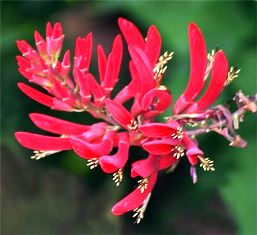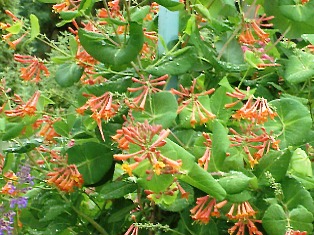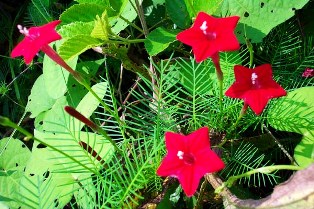 Birders
who want to host hummingbirds in their backyards need to plan
bird-friendly landscaping, especially flowers that attract hummingbirds.
Flowers that are especially adapted for hummingbird pollination are long
and tube-shaped and often red. Browse through our alphabetical list of
native Florida plants and find the ones that are best suited for your
yard or garden! Birders
who want to host hummingbirds in their backyards need to plan
bird-friendly landscaping, especially flowers that attract hummingbirds.
Flowers that are especially adapted for hummingbird pollination are long
and tube-shaped and often red. Browse through our alphabetical list of
native Florida plants and find the ones that are best suited for your
yard or garden!
 Coral
Bean ( Erythrina herbacea)-
Coral bean is is native to hardwood hammocks in the deep southern states
of the eastern United States, including Florida. Coral bean is deciduous
and has interesting compound leaves made up of three leaflets that are
uniquely shaped with pointed tips and a bulge in the middle. In late
spring and early summer showy scarlet blossoms appear. These long
flattened tubes are about 2 inches long by approximately 1/8 inch in
diameter. They are arranged in clusters at the stem tips and appear
custom designed for hummingbird beaks. Flowers are followed by large
pods that split open to reveal bright red seeds in late summer and fall.
Coral bean produces herbaceous stems from a woody base that are
typically about 3 feet in height but sometimes more. In areas that
experience freezes the stems are killed back in winter but in frost-free
areas the plant will form woody stems and may grow to 16 feet in height.
This South Florida form is sometimes referred to as E. arborea ,
a name that most authorities now consider a synonym. Coral
Bean ( Erythrina herbacea)-
Coral bean is is native to hardwood hammocks in the deep southern states
of the eastern United States, including Florida. Coral bean is deciduous
and has interesting compound leaves made up of three leaflets that are
uniquely shaped with pointed tips and a bulge in the middle. In late
spring and early summer showy scarlet blossoms appear. These long
flattened tubes are about 2 inches long by approximately 1/8 inch in
diameter. They are arranged in clusters at the stem tips and appear
custom designed for hummingbird beaks. Flowers are followed by large
pods that split open to reveal bright red seeds in late summer and fall.
Coral bean produces herbaceous stems from a woody base that are
typically about 3 feet in height but sometimes more. In areas that
experience freezes the stems are killed back in winter but in frost-free
areas the plant will form woody stems and may grow to 16 feet in height.
This South Florida form is sometimes referred to as E. arborea ,
a name that most authorities now consider a synonym.
 Coral
Honeysuckle (Lonicera sempervirens)- Coral honeysuckle
grows wild in open woodlands, roadsides, fence rows and the edges of
clearings, from Connecticut to Nebraska, and south to Texas and
Florida..Coral honeysuckle is a twining or trailing woody vine
that is evergreen or tardily deciduous in mild climates. The smooth
leaves are 1-3 inches long and arranged opposite each other along the
stem. The last two leaves at the ends of new growth are joined at their
bases, cup-like around the stem and the showy flowers are in terminal
clusters just beyond. The flowers are tube shaped, about 2 inches long,
coral red or bright orange on the outside and yellow on the inside. The
fruits are orange red berries, about 0.25 inch diameter..Wherever coral
honeysuckle grows, ruby-throated hummingbirds and butterflies will find
it. Songbirds relish the juicy fruits. This is a spectacular vine that
the local wildlife will enjoy as much as you. Coral
Honeysuckle (Lonicera sempervirens)- Coral honeysuckle
grows wild in open woodlands, roadsides, fence rows and the edges of
clearings, from Connecticut to Nebraska, and south to Texas and
Florida..Coral honeysuckle is a twining or trailing woody vine
that is evergreen or tardily deciduous in mild climates. The smooth
leaves are 1-3 inches long and arranged opposite each other along the
stem. The last two leaves at the ends of new growth are joined at their
bases, cup-like around the stem and the showy flowers are in terminal
clusters just beyond. The flowers are tube shaped, about 2 inches long,
coral red or bright orange on the outside and yellow on the inside. The
fruits are orange red berries, about 0.25 inch diameter..Wherever coral
honeysuckle grows, ruby-throated hummingbirds and butterflies will find
it. Songbirds relish the juicy fruits. This is a spectacular vine that
the local wildlife will enjoy as much as you.
 Cross
Vine (Bignonia capreolata)- Cross Vine 'Tangerine Beauty' is a
woody vine or shrub is commonly grown on trelliswork or walls and grows
to an average height of 10 to 20 feet, but can reach up to 30'. This
vine clings to objects with tendrils that usually will not damage the
object like other vines, and has narrow bell-shaped flowers. The flowers
of Tangerine Beauty are 2 inches long, cluster at the leaf axils and
have yellow throats surrounded by tangerine colored tubes. Cross Vine
flowers from late spring and throughout the summer. Cross Vine is native
to southeastern North America, from Maryland to Florida, and west to
Missouri and Texas. It occurs widely in uplands, lowlands, forests, and
clearings, and is hardy to USDA Zone 6. Cross vine is one of the first
red, trumpet shaped flowers to greet returning hummingbirds in early
spring. Fast-growing cross vine makes an outstanding screen when trained
to a trellis. The vine will clamber up a tall pine tree, while
brilliantly colored clusters of trumpet flowers cascade back down along
the trunk. Cross
Vine (Bignonia capreolata)- Cross Vine 'Tangerine Beauty' is a
woody vine or shrub is commonly grown on trelliswork or walls and grows
to an average height of 10 to 20 feet, but can reach up to 30'. This
vine clings to objects with tendrils that usually will not damage the
object like other vines, and has narrow bell-shaped flowers. The flowers
of Tangerine Beauty are 2 inches long, cluster at the leaf axils and
have yellow throats surrounded by tangerine colored tubes. Cross Vine
flowers from late spring and throughout the summer. Cross Vine is native
to southeastern North America, from Maryland to Florida, and west to
Missouri and Texas. It occurs widely in uplands, lowlands, forests, and
clearings, and is hardy to USDA Zone 6. Cross vine is one of the first
red, trumpet shaped flowers to greet returning hummingbirds in early
spring. Fast-growing cross vine makes an outstanding screen when trained
to a trellis. The vine will clamber up a tall pine tree, while
brilliantly colored clusters of trumpet flowers cascade back down along
the trunk.
 Cypress
Vine (Ipomea quamoclit)- Cypress-vine is a very attractive
twining morning-glory with smooth stems, lacy leaves and scarlet
flowers. The leaves are 3-4 inches long and feather-like, finely divided
pinnately into threadlike segments. The scarlet red (rarely white)
flowers are tubular, about 1.5 inch long, and flare out at the mouth
into a five-pointed star. Under ideal conditions the vine can climb to
20 feet or more, but it is always a dainty, fragile vine and not at all
aggressive. Cypress-vine is the perfect plant for the just-germinating
gardener. The seeds are relatively large, easy to handle and take only 4
days to sprout; the cotyledons (seed leaves) are large and distinctive,
looking like swept-back airplane wings; the next leaves to appear are
the handsome feathery leaves that distinguish the plant; the vine grows
quickly, producing beautiful scarlet flowers in less than 30 days. Then
the butterflies and hummingbirds come! Cypress
Vine (Ipomea quamoclit)- Cypress-vine is a very attractive
twining morning-glory with smooth stems, lacy leaves and scarlet
flowers. The leaves are 3-4 inches long and feather-like, finely divided
pinnately into threadlike segments. The scarlet red (rarely white)
flowers are tubular, about 1.5 inch long, and flare out at the mouth
into a five-pointed star. Under ideal conditions the vine can climb to
20 feet or more, but it is always a dainty, fragile vine and not at all
aggressive. Cypress-vine is the perfect plant for the just-germinating
gardener. The seeds are relatively large, easy to handle and take only 4
days to sprout; the cotyledons (seed leaves) are large and distinctive,
looking like swept-back airplane wings; the next leaves to appear are
the handsome feathery leaves that distinguish the plant; the vine grows
quickly, producing beautiful scarlet flowers in less than 30 days. Then
the butterflies and hummingbirds come!
 |
|


 Birders
who want to host hummingbirds in their backyards need to plan
bird-friendly landscaping, especially flowers that attract hummingbirds.
Flowers that are especially adapted for hummingbird pollination are long
and tube-shaped and often red. Browse through our alphabetical list of
native Florida plants and find the ones that are best suited for your
yard or garden!
Birders
who want to host hummingbirds in their backyards need to plan
bird-friendly landscaping, especially flowers that attract hummingbirds.
Flowers that are especially adapted for hummingbird pollination are long
and tube-shaped and often red. Browse through our alphabetical list of
native Florida plants and find the ones that are best suited for your
yard or garden! Coral
Bean ( Erythrina herbacea
Coral
Bean ( Erythrina herbacea Coral
Honeysuckle (Lonicera sempervirens
Coral
Honeysuckle (Lonicera sempervirens Cross
Vine (Bignonia capreolata)- Cross Vine 'Tangerine Beauty' is a
woody vine or shrub is commonly grown on trelliswork or walls and grows
to an average height of 10 to 20 feet, but can reach up to 30'. This
vine clings to objects with tendrils that usually will not damage the
object like other vines, and has narrow bell-shaped flowers. The flowers
of Tangerine Beauty are 2 inches long, cluster at the leaf axils and
have yellow throats surrounded by tangerine colored tubes. Cross Vine
flowers from late spring and throughout the summer. Cross Vine is native
to southeastern North America, from Maryland to Florida, and west to
Missouri and Texas. It occurs widely in uplands, lowlands, forests, and
clearings, and is hardy to USDA Zone 6. Cross vine is one of the first
red, trumpet shaped flowers to greet returning hummingbirds in early
spring. Fast-growing cross vine makes an outstanding screen when trained
to a trellis. The vine will clamber up a tall pine tree, while
brilliantly colored clusters of trumpet flowers cascade back down along
the trunk.
Cross
Vine (Bignonia capreolata)- Cross Vine 'Tangerine Beauty' is a
woody vine or shrub is commonly grown on trelliswork or walls and grows
to an average height of 10 to 20 feet, but can reach up to 30'. This
vine clings to objects with tendrils that usually will not damage the
object like other vines, and has narrow bell-shaped flowers. The flowers
of Tangerine Beauty are 2 inches long, cluster at the leaf axils and
have yellow throats surrounded by tangerine colored tubes. Cross Vine
flowers from late spring and throughout the summer. Cross Vine is native
to southeastern North America, from Maryland to Florida, and west to
Missouri and Texas. It occurs widely in uplands, lowlands, forests, and
clearings, and is hardy to USDA Zone 6. Cross vine is one of the first
red, trumpet shaped flowers to greet returning hummingbirds in early
spring. Fast-growing cross vine makes an outstanding screen when trained
to a trellis. The vine will clamber up a tall pine tree, while
brilliantly colored clusters of trumpet flowers cascade back down along
the trunk.